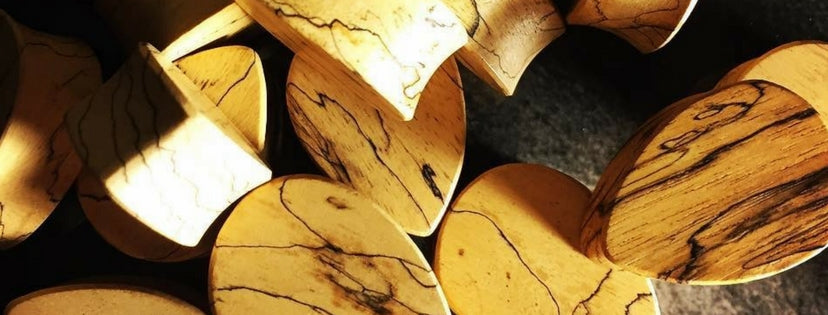Looking to stretch your lobes but aren't sure where to start? We're here to help!
Whether you're just starting your ear stretching journey, or working towards that ever-elusive goal size - safe earlobe stretching practices are essential to maintaining healthy lobes. In this article we'll go over a few of the most common stretching methods, as well as tips and tricks to make sure your next stretch goes smoothly.
Getting Started
The first thing you'll need to decide when stretching your ears, is what size you want for your first stretch. Generally, 14 Gauge is a good starting point for people who have worn regular earrings daily for an extended period of time. If your ears are freshly healed or not used to wearing jewelry, 16 Gauge might be a safer starting as not to push your lobes too far too quickly. Remember - ear stretching is a journey and not a race. Stretching too quickly can cause injury and prevent your ears from healing properly.
How far can I stretch without permanent holes?
This is a very common question, and unfortunately one without a simple answer. Everyone's body is different, factors such as skin elasticity can affect just how large you can stretch and still have your lobes go back to normal. A widely accepted answer is to not go larger than 2-0 Gauge if you think you may want to remove your plugs in the future.
Additionally, stretching slowly and not skipping sizes will have a huge impact on how well your ears heal. Stretching too fast or skipping sizes can cause tearing which will make the healing process harder for your lobes. We've already said this once, but we can't stress it enough: Ear stretching is a journey, and not a race!
How long should I wait between stretches?
This is another question that unfortunately has no simple answer. Because everyone's body is different, some people may be able to stretch quicker than others. It's recommended you wait at least 5-6 weeks between stretches, however, if you're ever in doubt whether your lobes are ready - just wait! The more time you allow your lobes to recover, the better they'll look in the long run, and the larger you'll be able to stretch.
How to stretch
The Taper Method:
Tapers are a long tool used to stretch your ears, most commonly available in either acrylic or steel. They are small on one end, and the desired size on the other. An important thing to remember about tapers is they are not intended to be worn as jewelry, because they put unnecessary weight on your lobes which can cause tearing.
We recommend using steel tapers because they can be properly sterilized, and are generally easier to insert than acrylic. However, if you're on a budget or don't have the option of using a steel taper, acrylic is a viable alternative.
The first thing you want to do is purchase a lubricant such as a jojoba oil, vitamin e oil, or any specialty stretching lubricant. This makes the taper go in smoothly and avoids any unnecessary friction during insertion. Once you've applied your lubricant of choice onto both the taper and your lobes, proceed to insert and push the taper through to the base. Take your time when doing this, and don't rush. Taking a few minutes to push it through to the base is completely fine! Once you've reached the larger base of the taper, simply follow through with your plug. High five, you've completed your stretch!
The Tape Method:
Once you reach a larger size such as 0G, the tape method becomes a great stretching option. It's a safe, albeit slower way to stretch. It's also the most common way to size up when you go above 1 inch.
To use this method you'll need your choice of either PTFE tape, or bondage tape, as well as a set of plugs (we strongly recommend using single flare plugs so that excess tape can be wrapped around the back of the plug.) Firstly, you'll want to take your plug, and do 2-3 wraps of tape around. Add an extra 2-3 wraps of tape every week to gradually increase the size. You'll also want to remember to change the tape daily and clean the plug to avoid bacteria. After about 1-2 months of this, you should be finished sizing up.
Aftercare Tips
What the funk is on my ears!?
Now that you have stretched lobes - we introduce you to ear funk. The wonderfully (not so much) cheesy smelling gunk you may notice on your plugs. Ear funk is made up of dead skin cells that are trapped between your lobes and jewelry. Don't worry, this is a common problem and easily enough avoided by washing your ears daily, and opting for organic body jewelry (our specialty!).
I think I might have an infection!
If you find you're having some pain, irritation, warmth, or discharge you may have an infection. This should always be handled immediately to reduce the risk of permanent lobe damage. Firstly, if you've just recently stretched up consider downsizing to give your lobes room to heal. We also recommend using steel jewelry as this minimizes the chances of the infection getting worse. If you find the infection is not going away - reach out to a local physician. It's always best to get a medical opinion as soon as possible in case it is something serious.
What's a blowout and how do I fix it?
The notorious blowout has dashed many stretchers' dreams. This is why it's important to fix your lobes, and not ignore the problem or you could do permanent damage that will stop your stretching journey dead in its tracks. Essentially, a blowout is when your fistula (the tunnel of skin that touches your jewelry) is forced out of the piercing. This generally occurs when you stretch too fast or skip sizes.
If you notice a blowout you should deal with it as soon as possible to avoid a permanent blowout look to your lobes. Consider removing your jewelry completely, or sizing down 2-3 sizes to let your ears heal. If you ignore the blowout, your lobes will heal with this loose skin and it can become permanent. While there's no guarantee that a blowout will heal, oftentimes if the necessary steps are taken as soon as it happens, there's a good chance your lobes will go back to normal.
How do I care for my new jewelry?
We've written a great little blog post to help you care for the wood plugs that we recommend you check out, but here's a quick summary.
- moisturizer your jewelry with jojoba oil.
- NEVER shower or swim with your wood plugs!
- Don't clean wood with alcohol. Use mild non-chemical soap instead!
- Keep your plugs out of sunlight and direct heat.
Stone/Steel jewelry is a bit more forgiving, you don't need to worry about most of these points, but we still recommend cleaning them with mild non-chemical soap instead of alcohol (much better for your lobes!).
You're good to go!
Now that you've stretched, there's nothing left to do but stock up on some awesome jewelry! Check out our huge selection of premium plugs and tunnels here.

